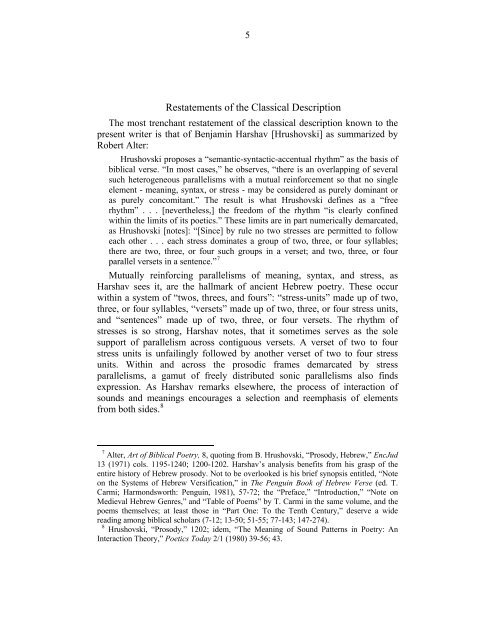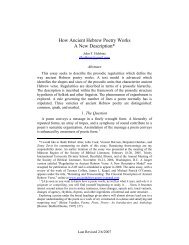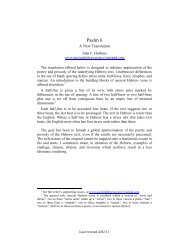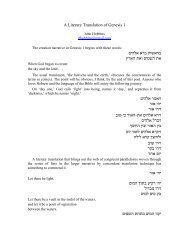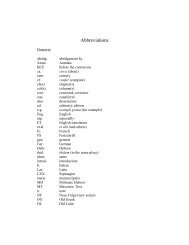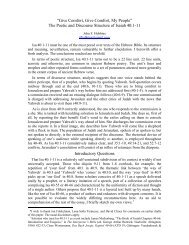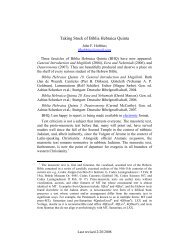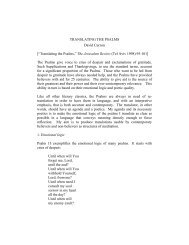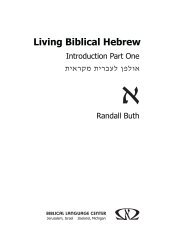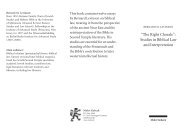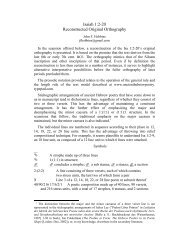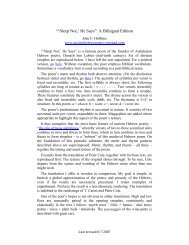Here - Ancient Hebrew Poetry - Typepad
Here - Ancient Hebrew Poetry - Typepad
Here - Ancient Hebrew Poetry - Typepad
- No tags were found...
Create successful ePaper yourself
Turn your PDF publications into a flip-book with our unique Google optimized e-Paper software.
5Restatements of the Classical DescriptionThe most trenchant restatement of the classical description known to thepresent writer is that of Benjamin Harshav [Hrushovski] as summarized byRobert Alter:Hrushovski proposes a “semantic-syntactic-accentual rhythm” as the basis ofbiblical verse. “In most cases,” he observes, “there is an overlapping of severalsuch heterogeneous parallelisms with a mutual reinforcement so that no singleelement - meaning, syntax, or stress - may be considered as purely dominant oras purely concomitant.” The result is what Hrushovski defines as a “freerhythm” . . . [nevertheless,] the freedom of the rhythm “is clearly confinedwithin the limits of its poetics.” These limits are in part numerically demarcated,as Hrushovski [notes]: “[Since] by rule no two stresses are permitted to followeach other . . . each stress dominates a group of two, three, or four syllables;there are two, three, or four such groups in a verset; and two, three, or fourparallel versets in a sentence.” 7Mutually reinforcing parallelisms of meaning, syntax, and stress, asHarshav sees it, are the hallmark of ancient <strong>Hebrew</strong> poetry. These occurwithin a system of “twos, threes, and fours”: “stress-units” made up of two,three, or four syllables, “versets” made up of two, three, or four stress units,and “sentences” made up of two, three, or four versets. The rhythm ofstresses is so strong, Harshav notes, that it sometimes serves as the solesupport of parallelism across contiguous versets. A verset of two to fourstress units is unfailingly followed by another verset of two to four stressunits. Within and across the prosodic frames demarcated by stressparallelisms, a gamut of freely distributed sonic parallelisms also findsexpression. As Harshav remarks elsewhere, the process of interaction ofsounds and meanings encourages a selection and reemphasis of elementsfrom both sides. 87 Alter, Art of Biblical <strong>Poetry</strong>, 8, quoting from B. Hrushovski, “Prosody, <strong>Hebrew</strong>,” EncJud13 (1971) cols. 1195-1240; 1200-1202. Harshav’s analysis benefits from his grasp of theentire history of <strong>Hebrew</strong> prosody. Not to be overlooked is his brief synopsis entitled, “Noteon the Systems of <strong>Hebrew</strong> Versification,” in The Penguin Book of <strong>Hebrew</strong> Verse (ed. T.Carmi; Harmondsworth: Penguin, 1981), 57-72; the “Preface,” “Introduction,” “Note onMedieval <strong>Hebrew</strong> Genres,” and “Table of Poems” by T. Carmi in the same volume, and thepoems themselves; at least those in “Part One: To the Tenth Century,” deserve a widereading among biblical scholars (7-12; 13-50; 51-55; 77-143; 147-274).8 Hrushovski, “Prosody,” 1202; idem, “The Meaning of Sound Patterns in <strong>Poetry</strong>: AnInteraction Theory,” Poetics Today 2/1 (1980) 39-56; 43.


